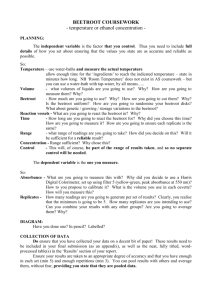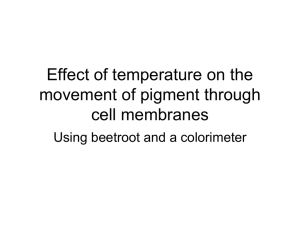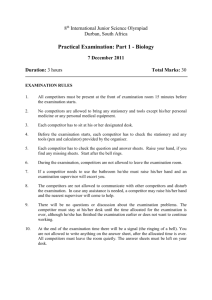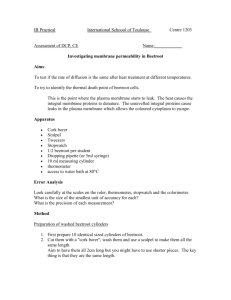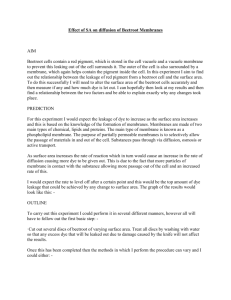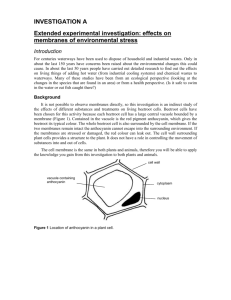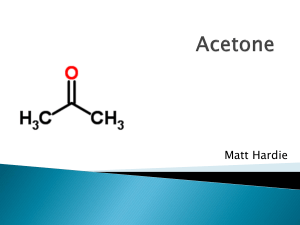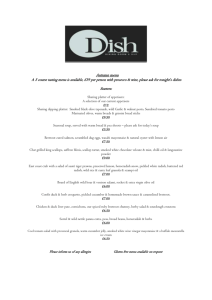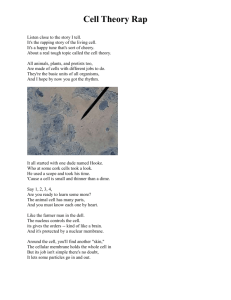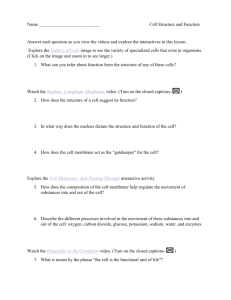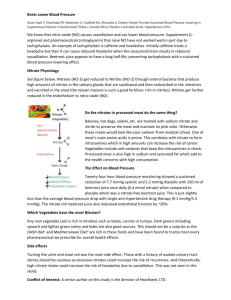Biology Practical MODEL ANSWERS
advertisement
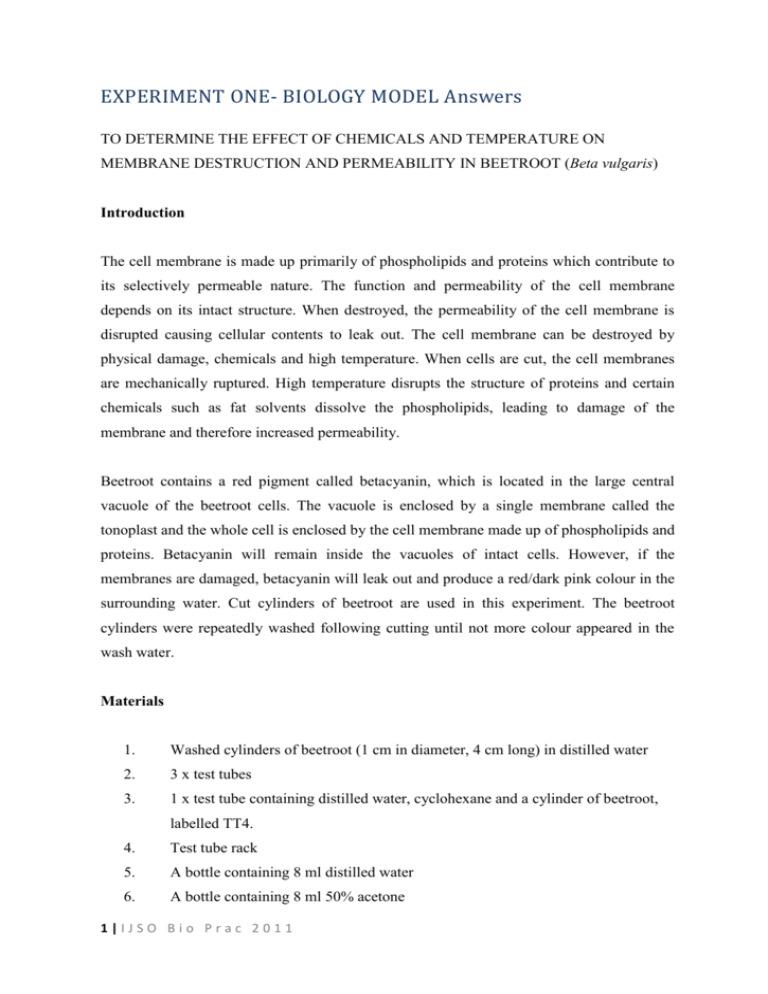
EXPERIMENT ONE- BIOLOGY MODEL Answers TO DETERMINE THE EFFECT OF CHEMICALS AND TEMPERATURE ON MEMBRANE DESTRUCTION AND PERMEABILITY IN BEETROOT (Beta vulgaris) Introduction The cell membrane is made up primarily of phospholipids and proteins which contribute to its selectively permeable nature. The function and permeability of the cell membrane depends on its intact structure. When destroyed, the permeability of the cell membrane is disrupted causing cellular contents to leak out. The cell membrane can be destroyed by physical damage, chemicals and high temperature. When cells are cut, the cell membranes are mechanically ruptured. High temperature disrupts the structure of proteins and certain chemicals such as fat solvents dissolve the phospholipids, leading to damage of the membrane and therefore increased permeability. Beetroot contains a red pigment called betacyanin, which is located in the large central vacuole of the beetroot cells. The vacuole is enclosed by a single membrane called the tonoplast and the whole cell is enclosed by the cell membrane made up of phospholipids and proteins. Betacyanin will remain inside the vacuoles of intact cells. However, if the membranes are damaged, betacyanin will leak out and produce a red/dark pink colour in the surrounding water. Cut cylinders of beetroot are used in this experiment. The beetroot cylinders were repeatedly washed following cutting until not more colour appeared in the wash water. Materials 1. Washed cylinders of beetroot (1 cm in diameter, 4 cm long) in distilled water 2. 3 x test tubes 3. 1 x test tube containing distilled water, cyclohexane and a cylinder of beetroot, labelled TT4. 4. Test tube rack 5. A bottle containing 8 ml distilled water 6. A bottle containing 8 ml 50% acetone 1|IJSO Bio Prac 2011 7. A bottle containing 8 ml 100% acetone 8. Permanent marker pen 9. 1x sheet graph paper Experimental procedure 1. Using the permanent marker pen, label the empty test tubes TT1, TT2, and TT3. 2. Prepare these 3 test tubes as follows (see Table 1): Pour the distilled water into TT1. Pour the 50% acetone into TT2. Pour the 100% acetone into TT3. 3. Place all tubes in the test tube rack. 4. Immediately place a washed cylinder of beetroot in TT1, TT2 and TT3. 5. Shake test tubes 1-4 gently for a few seconds. 6. After 15 minutes observe the colour of the solution in each test tube. Table 1: Solvents in Test Tubes 1-4 TEST TUBES SOLVENTS Test tube 1 Test tube 2 Test tube 3 Test tube 4 (TT1) (TT2) (TT3) (TT4) Distilled water 50% Acetone 100% Acetone Distilled water + Cyclohexane 2|IJSO Bio Prac 2011 SECTION 1 a. At the start of the experiment, the distilled water surrounding the washed cylinders of beetroot appeared clear in colour. Why? Choose the correct answer by ticking the appropriate box. i. Betacyanin is not soluble in water. ii. Betacyanin is soluble in organic solvents only. iii. Damaged cells were empty of betacyanin after repeated washing, and no further cell membrane damage occurred. iv. All the above. (0.5 mark) b. Which test tube represents the control? Choose the correct answer by ticking the appropriate box. TT1 TT2 TT3 TT4 (0.5 mark) c. Based on the colour of the solution in TT2 and TT3, where was betacyanin more soluble? Choose the correct answer by ticking the appropriate box. 50% acetone 100% acetone (0.5 mark) d. In TT4 which layer represents water? Choose the correct answer by ticking the appropriate box. Upper Lower (0.5 mark) 3|IJSO Bio Prac 2011 e. Why was the water coloured in TT4 but NOT in TT1? Choose the correct answer by ticking the appropriate box. i. The cell membranes in TT1 were not further disrupted. ii. Cyclohexane dissolved the lipids in the cell membranes in TT4, causing betacyanin to leak out. iii. Cyclohexane dissolved the lipids in the cell membranes in TT4, causing betacyanin to leak out. The betacyanin which leaked out were soluble only in the water and not in the cyclohexane. iv. All the above statements are correct. (0.5 mark) SECTION 2 f. An experiment to determine the effect of temperature on membrane structure and permeability in beetroot was conducted earlier this week. The washed cylinders of beetroot were placed in test tubes containing distilled water and then incubated at 20ºC, 30ºC, 40ºC, 60ºC and 80ºC for 15 minutes. Thereafter the absorbance of the solution in each test tube was recorded at a wavelength of 605 nm. Distilled water was used as the blank. The experiment was repeated three times and the data is shown in Table 2 below. The absorbance is a measure of the amount of light absorbed by the sample. The darker the sample the greater the absorbance. Answer the following based on the information given in this extract (f) and Table 2 below. i. Complete Table 2 by calculating the mean absorbance at each temperature and record in the column provided. (1 mark) ii. Based on the mean absorbance values, at what temperature did the proteins in the membranes begin to denature? Write your answer in the box below. 30˚C (0.5 mark) 4|IJSO Bio Prac 2011 iii. Plot a graph on the graph paper provided using the mean absorbance to show the effect of temperature on membrane permeability in beetroot. (See at end of paper) (2.5 marks) Table 2: Effect of temperature on membrane permeability in beetroot Temperature (ºC) Absorbance Sample A Sample B Sample C Mean 20 0.000 0.000 0.000 0.000 30 0.023 0.013 0.012 0.016 40 0.018 0.025 0.032 0.025 60 0.144 0.176 0.213 0.178 80 0.384 0.474 0.492 0.450 SECTION 3 g. The mean absorbance readings of the solutions in TT2 and TT3 (in the first experiment) were 0.084 and 0.054 respectively. Indicate whether the following statements are true or false. Write T or F in the box provided. T i. Betacyanin requires water for maximum solubility ii. Betacyanin is more soluble in 100% acetone than in 50% acetone F (0.5 x 2= 1 mark) h. From all the information gathered in these experiments on beetroot, in which solvent/s was betacyanin soluble? Choose the correct answer by ticking the appropriate box/es. Cyclohexane Water Hot water (0.25x2= 0.5 mark) 5|IJSO Bio Prac 2011 SECTION 4 i. Indicate whether the following statements are true (T) or false (F) in the answer sheet. TRUE FALSE i. NaCl caused plasmolysis in the beetroot cells. ii. NaCl dissolved the lipids in the cell membranes. iii. The beetroot cells absorbed NaCl and became turgid. iv. The beetroot cells lost betacyanin to the surrounding water. (0.5 x 4 = 2 mark) 6|IJSO Bio Prac 2011 0.5 0.45 0.4 Absorbance y axis 0.35 0.3 0.25 0.2 0.15 0.1 0.05 0 20 30 40 Temperature ˚C 60 80 x axis Figure1: Effect of temperature on membrane permeability in beetroot Mark scheme 0.25 For each plotted point = 1.5 0.25 For each correct axis label = 0.5 0.25 For line itself = 0.25 0.25 For caption = 0.25. No penalty if Figure 1 is not written. Must have caption. TOTAL MARK 10 7|IJSO Bio Prac 2011
